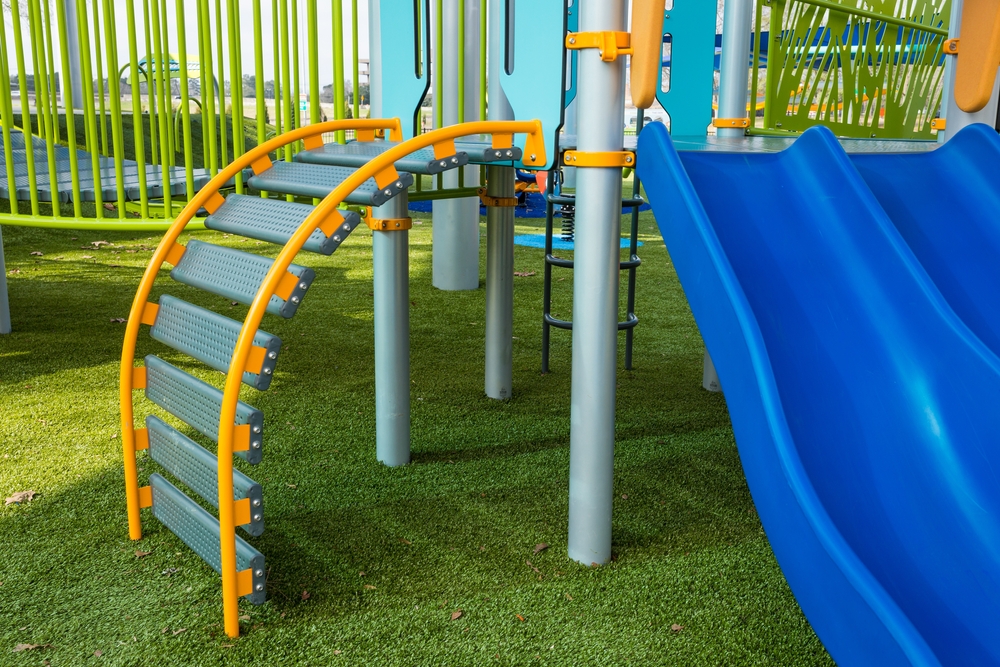What Flooring Is Best For Playgrounds?

Around 70% of injuries that kids experience happen from playground falls. That’s why you need proper flooring installed in your playground – kids are reckless, and you must do what you can to shield them from these injuries.
Whether installing a commercial playground or something for your backyard, you have many options for keeping kids safe. Here are a few of the most common playground floorings, from sand to rubber to artificial grass for playgrounds.
1. Gravel
Pea gravel is an affordable loose-fill playground material. It has a few upsides – pests can’t live in it, and it’s natural. But it doesn’t decompose. It’s resistant to rain and moisture. And best of all, it’s cheap and easy to install. You don’t need to know a lot about installation to install gravel.
But gravel has some pretty nasty downsides. First, it’s not ADA-compliant. Anyone with limited mobility will have trouble navigating across it, so gravel’s not an option if this is a commercial playground. It can be swallowed easily and even choked on. It’s not great at cushioning falls, either.
It can even get embedded in shoes and scratch up hardwood. Its maintenance isn’t easy, either – it needs to be refilled a lot and doesn’t do well in the snow. Overall, gravel is not a great option.
2. Sand
Playground sand is another affordable and clean option. It rarely harbors microbes.
But sand also isn’t ADA-compliant. And as a wise man once said, it’s coarse, rough, irritating, and it gets everywhere. It’s also attractive to animals, who might see it as a convenient litter box. It’s not even great at absorbing falls, and it can solidify when combined with dirt or in the cold.
Maintenance is a headache, too. You have to replace the sand once a year and regularly rake it for things like rocks, twigs, and glass.
You should be careful about the type of sand you buy, too. Opt for playground sand over construction sand. Be sure your sand has no asbestos or silica.
3. Wood Chips
Wood chips come in two varieties – regular wood chips and engineered wood fiber, or EWF. As a whole, EWF is a much better material.
Regular wood gets splintery and full of termites. It decomposes unless the manufacturers treat it with harmful chemicals. It’s also not accessible. EWF, on the other hand, has none of these flaws. EWF is both affordable and durable. It’s great at absorbing impact and is climate resistant with proper water absorption. It’s even composed of renewable materials.
But EWF needs to be installed correctly and maintained to be accessible. Even then, it’s not the most accessible material (although it is ADA-compliant). It also needs to be raked, presents a choking hazard, and can get pretty dusty.
4. Rubber Mulch
Rubber mulch is the most shock-absorbing loose-fill material. All-in-all, it’s easily one of your safest options. It also lasts a long time and is resistant to mold.
Unfortunately, it’s not ADA-compliant. And like all loose-fill materials, you need to rake it. It can also get quite hot in the summer and draws insects. It’s slightly more expensive than other loose-fill materials, so topping it off all the time adds up.
5. Rubber Tiles
Rubber is both safe and low-maintenance, and rubber tiles are ADA-compliant. They also drain water well.
Unfortunately, all rubber surfaces are expensive. Debris can get in the tile’s cracks, and they can get warped and become a tripping hazard. On top of that, you need a professional to install these.
6. Poured Rubber
Like rubber tiles, poured rubber is one of the safest options available. It’s also highly accessible and ADA-compliant. It doesn’t attract animals or other pests, and it’s simple to clean and maintain.
Unfortunately, poured rubber is so expensive that it’s rarely an option for people. It can also become hardened when exposed to too many UV rays and tends to heat up fast. And once again, it requires hiring a professional for installation.
7. Artificial Grass For Playgrounds
Artificial grass for playgrounds is one of the best playground surfaces out there. It’s easy to navigate even with mobility issues. It’s low maintenance, only needing to be hosed down every once in a while. It can even last decades with proper care. It’s eco-friendly and clean.
And, unlike natural grass, you won’t have to deal with pollen or pests on artificial grass for playgrounds. You can get all that while still having a natural look!
Artificial grass for playgrounds can get hot in the summer. You need it installed with protective underpadding, but with that, it has effective shock absorption. It can also be more expensive than other options and requires installation from turf professionals. But if you can afford it, it’s a great option.
Conclusion
You have many options for covering your playground floor – but some are better than others. Unfortunately, many of the best options, like rubber and artificial grass for playgrounds, can be prohibitively expensive.
It’s up to you to decide how much of your budget goes into the playground flooring and how much you need to make room for things like accessibility, fall safety, and maintenance.




